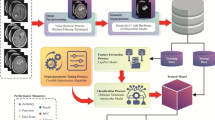Abstract
Medical images of the same modality but acquired at different centers, with different machines, using different protocols, and by different operators may have highly variable quality. Due to its limited generalization ability, a deep learning model usually cannot achieve the same performance on another database as it has done on the database with which it was trained. In this paper, we use the segmentation of brain magnetic resonance (MR) images as a case study to investigate the possibility of improving the performance of medical image analysis via normalizing the quality of images. Specifically, we propose a memory network (MemNet)-based algorithm to normalize the quality of brain MR images and adopt the widely used 3D U-Net to segment the images before and after quality normalization. We evaluated the proposed algorithm on the benchmark IBSR V2.0 database. Our results suggest that the MemNet-based algorithm can not only normalize and improve the quality of brain MR images, but also enable the same 3D U-Net to produce substantially more accurate segmentation of major brain tissues.
Access this chapter
Tax calculation will be finalised at checkout
Purchases are for personal use only
Similar content being viewed by others
References
Zhang, T., Xia, Y., Feng, D.D.: Hidden Markov random field model based brain MR image segmentation using clonal selection algorithm and Markov chain Monte Carlo method. Biomed. Signal Process. Control 12(1), 10–18 (2014)
Wei, J., Xia, Y., Zhang, Y.N.: M3Net: a multi-model, multi-size, and multi-view deep neural network for brain magnetic resonance image segmentation. Pattern Recogn. 91, 366–378 (2019)
Yang, Q.S., et al.: Low-dose CT image denoising using a generative adversarial network with Wasserstein distance and perceptual loss. IEEE Trans. Med. Imaging 37(6), 1348–1357 (2018)
Ran, M.S., et al.: Denoising of 3D magnetic resonance images using a residual encoder–decoder Wasserstein generative adversarial network. Med. Image Anal. 55, 165–180 (2019)
Chang, H.B., et al.: A new variational method for bias correction and its applications to rodent brain extraction. IEEE Trans. Med. Imaging 36(3), 721–733 (2017)
Feng, C.L., Zhao, D.Z., Huang, M.: Image segmentation and bias correction using local inhomogeneous iNtensity clustering (LINC): a region-based level set method. Neurocomputing 219, 107–129 (2017)
Zhan, S., Yang, X.: MR image bias field harmonic approximation with histogram statistical analysis. Pattern Recogn. Lett. 83, 91–98 (2016)
Shinohara, R.T., et al.: Statistical normalization techniques for magnetic resonance imaging. NeuroImage Clin. 6, 9–19 (2014)
Shafee, R., Buckner, R.L., Fischl, B.: Gray matter myelination of 1555 human brains using partial volume corrected MRI images. NeuroImage 105, 473–485 (2015)
Tai, Y., Yang, J., Liu, X.M., Xu, C.Y.: MemNet: a persistent memory network for image restoration. In: IEEE International Conference on Computer Vision, pp. 4539–4547 (2017)
Çiçek, Ö., Abdulkadir, A., Lienkamp, S.S., Brox, T., Rooneberger, O.: 3D U-Net: learning dense volumetric segmentation from sparse annotation. In: International Conference on Medical Image Computing and Computer-Assisted Intervention, pp. 234–241 (2015)
School, M.G.H.H.M.: The Internet Brain Segmentation Repository (IBSR). http://www.cma.mgh.harvard.edu/ibsr/index.html
Rohlfing, T.: Image similarity and tissue overlaps as surrogates for image registration accuracy: widely used but unreliable. IEEE Trans. Med. Imaging 31(2), 153–163 (2012)
Bharatha, A., et al.: Evaluation of three-dimensional finite element-based deformable registration of pre- and intra-operative prostate imaging. Med. Phys. 28(12), 2551–2560 (2001)
Wang, Z., Bovik, A.C., Sheikh, H.R., Simoncelli, E.P.: Image quality assessment: from error visibility to structural similarity. IEEE Trans. Image Process. 13(4), 600–612 (2004)
Glorot, X., Bengio, Y.: Understanding the difficulty of training deep feedforward neural networks. In: 13th International Conference on Artificial Intelligence and Statistics (2010)
Mao, X., Shen, C., Yang, Y.: Image restoration using very deep convolutional encoder-decoder networks with symmetric skip connections. In: Neural Information Processing Systems (2016)
Zhang, K., Zuo, W., Chen, Y., Meng, D., Zhang, L.: Beyond a gaussian denoiser: Residual learning of deep CNN for image denoising. IEEE Trans. Image Process. 26(7), 3142–3155 (2017)
Acknowledgement
This work was supported in part by the Science and Technology Innovation Committee of Shenzhen Municipality, China, under Grants JCYJ20180306171334997, and in part by the National Natural Science Foundation of China under Grants 61771397, in part by the Northwestern Polytechnical University Graduate School and Enterprise Cooperative Innovation Fund under Grant XQ201911, and in part by the Project for Graduate Innovation team of Northwestern Polytechnical University.
Author information
Authors and Affiliations
Corresponding author
Editor information
Editors and Affiliations
Rights and permissions
Copyright information
© 2019 Springer Nature Switzerland AG
About this paper
Cite this paper
Su, Y., Wei, J., Ma, B., Xia, Y., Zhang, Y. (2019). Memory Network-Based Quality Normalization of Magnetic Resonance Images for Brain Segmentation. In: Cui, Z., Pan, J., Zhang, S., Xiao, L., Yang, J. (eds) Intelligence Science and Big Data Engineering. Visual Data Engineering. IScIDE 2019. Lecture Notes in Computer Science(), vol 11935. Springer, Cham. https://doi.org/10.1007/978-3-030-36189-1_5
Download citation
DOI: https://doi.org/10.1007/978-3-030-36189-1_5
Published:
Publisher Name: Springer, Cham
Print ISBN: 978-3-030-36188-4
Online ISBN: 978-3-030-36189-1
eBook Packages: Computer ScienceComputer Science (R0)




